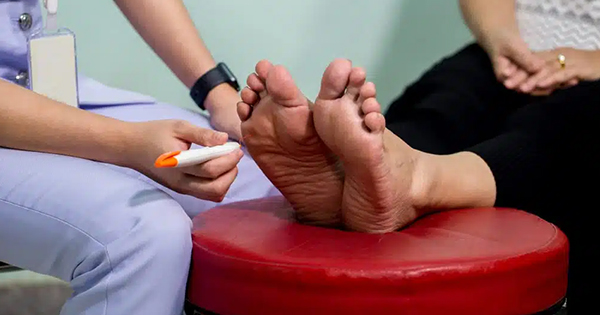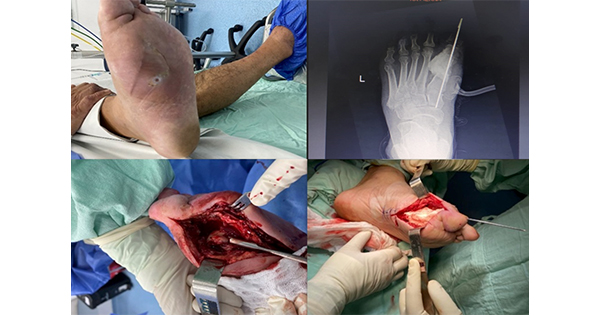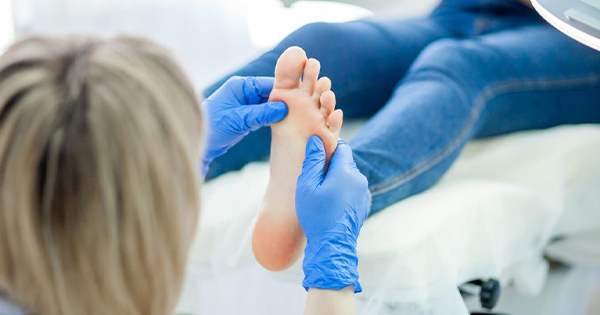Between 19 and 34% of people living with diabetes will develop a foot ulcer and approximately 20% of people who develop a diabetic foot ulcer (DFU) will require lower-extremity amputation (Armstrong et al, 2017; McDermott et al, 2023). Delaying access to a specialist foot protection service (FPS) is a barrier to effective diabetic foot care (Vas et al, 2018). It is vital that patients with diabetes on identification of a potential DFU access their local FPS promptly, either self-referring directly or via a healthcare professional (HCP).
The National Diabetes Foot Care Audit (NDFA) gathers data from each episode of diabetic foot ulceration and how the patient presents to an FPS. “Self-presenting” for the purposes of the NDFA means that the patient was not referred to the FPS for the new ulcer by an HCP (NHS England, 2024). At present, any patient who self-presents, whether they are aware of the ulcer or not, falls within the self-presenting category in the NDFA. Some patients unaware they have a new DFU can self-present for routine foot care, meaning the new DFU is an incidental finding during the consultation. Some patients recorded as self-presenting in the NDFA data may include individuals who have not contacted the FPS because of the ulcer.
With a pressing need to focus on DFU prevention, the IWGDF guidelines cite good foot self-care behaviours as integral to the prevention of the development of DFUs (Bus and van Netten, 2016; Bus et al, 2024). They recommend patients are educated to examine their feet daily and, with the presence or suspicion of having a (pre-)ulcerative lesion, to rapidly contact an appropriately trained HCP for further advice (Bus et al, 2024). However, multiple factors can affect an individual’s capacity to engage with their foot health (van Netten et al, 2019).
Studies have not explored the incidental finding of DFUs in patients who self-present to community foot protection services, and little is known about the experiences and perspectives of this patient group specifically. Their experiences are relevant to foot protection service provision and commissioning of community foot protection services. This quality improvement project sought to learn what proportion of patients self-presenting with a new DFU in a community FPS were aware of the presence of the ulcer and for what proportion the DFU was an incidental finding, and then to explore self-presenting patients’ perspectives on foot self-care and accessing the FPS.
Methods
Project design
This quality improvement project was a multiphase study undertaken in Lewisham Foot Health Service, in south-east London. This service offers routine podiatric care and community foot ulcer care across six clinic locations in the borough of Lewisham, with access to a multidisciplinary foot team (MDFT) in Lewisham Hospital as required. The first phase gathered quantitative data and served to screen for participants to be recruited into the second qualitative phase. The two phases ran concurrently.
Phase 1
The first objective of Phase 1 was to gather quantitative data from patient electronic health records (EHR) to identify which patients were self-presenting to the FPS, within the NDFA definition (NHS England 2024). This enabled eligible participants from this self-presenting group to be recruited to the second phase. The second objective was to collect data from EHR on the characteristics of those self-presenting (Box 1), potentially to aid recognising patients less likely to contact the FPS with a new DFU. Due to the limited time available, the sample size for the participants that could be recruited to Phase 1 was anticipated to be between 30 and 40 participants, based on experience of previous NDFA data collection. While the findings would be of interest to this FPS, they would not be generalisable to a wider population with this limited sample size.
Phase 2
The objective of the second qualitative phase was to gain a deeper understanding of the self-presenting patients’ perspectives regarding foot self-care and accessing the FPS, to complement and build upon the quantitative data. Phase 2 would gather one-to-one interview data from up to 12 patients, who were identified as self-presenting. The intention was that analysing both quantitative and qualitative data would enhance the usefulness of the study findings, guiding further improvement projects to support patients with diabetes.
A podiatrist within the FPS carried out the interviews, not wearing the podiatrist uniform, to differentiate between a clinic consultation and research interview. The interviews were semi-structured following the questionnaire in Box 2. All interviews were audio-recorded and transcribed anonymously, labelled with pseudonyms, for analysis. Audio recordings were deleted following transcription.
The interview questions were chosen to encourage the interviewee to discuss their own perspectives on checking their feet and accessing the FPS. Question 4 also explored their perspectives on the following foot health education materials:
- The FPS’s diabetes foot risk categorisation advice leaflet
- The ACT NOW visual prompt produced by the iDEAL (Insights for Diabetes Excellence, Access and Learning) group (Edmonds et al, 2020), adapted to include a QR code for accessing the FPS self-referral form
- Images of individuals checking their feet.
Recruitment
Phase 1
Convenience sampling was used to recruit as many participants as possible that presented to the FPS during a 12-week project period in 2024. All individuals who met all of the following eligibility criteria were included in Phase 1:
- Has diabetes
- Has a new DFU where feet were intact previously
- Not referred into the FPS for this DFU by another HCP. This was confirmed by checking the most recent referral recorded in the EHR (“self-presenting”).
For each patient recruited, the categories of data listed in Box 1 were collected from EHR, anonymised, password secured and saved on NHS secure systems. Answers to questions 3–8 are recorded routinely as part of patient care. Answers to questions 1 and 2 were noted on an adapted NDFA data collection form (Figure 1) by each treating podiatrist.
Phase 2
Phase 1 participants who were eligible for Phase 2 were provided with a patient information leaflet (PIL) by the treating podiatrist, inviting them to participate in an interview. The subject matter of the interview process did not pose any risk to the interviewees; however, as a precaution, podiatrists were asked not to provide the PIL to vulnerable individuals. Before inviting a patient to interview, the patient’s EHR were checked to ensure they had no vulnerable characteristics (including very frail individuals and individuals with current mental health problems). Eligible interviewees were invited for interviews as they presented to the service, and interviews continued until there was deemed to be data saturation. The patients were given time to read the PIL and were subsequently contacted by telephone inviting them to attend an interview. If they agreed to participate, they were asked to sign the consent form and bring this to the interview. Nine interviews were completed; characteristics of the interviewees are shown in Table 1. A convenient time and clinic location for the interview was agreed with the interviewee.
Data analysis methods
Phase 1
It was anticipated that too few participants could be recruited in the time available for generalisable findings to be possible. Descriptive statistics only were generated from the Phase 1 data, looking at the frequency of the three categories within the sample:
- Self-presented, aware of the DFU and contacted the service
- Self-presented, aware of DFU but did not contact service
- Self-presented and unaware of ulcer.
The frequency of the presence of the risk factors of neuropathy, visual impairment and inability to self-care were recorded, along with the age bracket, sex and ethnicity of the participants.
Phase 2
Transcription and analysis of the data were performed by the interviewer, a podiatrist within the FPS, not known to the interviewees but familiar with DFU management. The individual analysing the data maintained a reflexive diary throughout. Following transcription, there was familiarisation with the data by reading and re-reading the transcripts. Literal coding of the interview transcripts was used in the first cycle of coding, using the comments function in Microsoft Word. A more inductive approach was taken to developing codes overall, discerning what patterns arose from the data; however, the study’s quality improvement objectives guided which codes should be retained, a more deductive approach (Saldaña, 2021). Codes were then topic coded (Saldaña, 2021). These topic groups were examined, looking for emergent themes, and these themes were checked back to see how they related to the original transcripts. An experiential approach to the data sought to remain close to the interviewees’ own experiences, while seeking to reduce critical analysis by the researcher, possibly influenced by their experience working with DFU patients (Byrne, 2022). Six themes that were coherent and relevant to the project’s purpose were identified.
Results
Phase 1 findings
There were 34 patients who self-presented to the FPS with a new DFU during the 12 weeks. Of the 34 participants, 14 were aware of the ulcer and had contacted the FPS seeking an appointment because of the ulcer. Six were aware of the ulcer but had not contacted the FPS and were attending because they already had a routine appointment booked. The remaining 14 were unaware of the ulcer and were attending a routine appointment (Figure 2). For 20 of the 34 participants, the ulcer was an incidental finding in a routine appointment (Figure 3).
There was no discernible pattern in the characteristics of neuropathy, visual impairment and inability to self-care in those for whom the new DFU was an incidental finding when compared to those who contacted the service. Figure 4 shows the incidence of risk factors relevant to awareness of ulceration in the sample.
The participants’ ages ranged between 50 and 89, with over 60% aged between 61 and 80. Nine were female and 25 were male. Six participants identified as Black, including Black British, Black Caribbean or African (17.6% of the sample, compared to 26.8% of the Lewisham resident population as taken from the 2021 census), four identified as Asian (11.8% compared to 9% of the local population), 20 identified as White (58.8%, compared to 51.5% of the local population) (Office for National Statistics, 2023).
Phase 2 findings
Of the nine individuals interviewed in Phase 2, all of whom self-presented to the FPS, all had loss of sensation, and all had experienced a previous DFU. The majority had experienced a previous minor amputation. Five contacted the service on account of the new DFU and for the other four interviewees, the new DFU was an incidental finding in a routine appointment. Of the four for whom it was an incidental finding, one was impeded in checking the plantar aspect due to leg bandaging and the other three were unaware due to not checking or not checking the whole foot, checking only a previous site of ulceration. Six themes were identified:
- The positive impact of foot health education
- The limitations of education
- Learning from lived experience
- Barriers to prompt self-referral
- Individualisation of education and self-care regimens
- Experience of service access.
Positive impact of foot self-care education
Interviewees discussed how, when they were first diagnosed with diabetes, they knew little about DFUs and how to prevent them. Patients needed to be given this information from the outset. The absence of symptoms in diabetes for many individuals at diagnosis, was associated with a lack of engagement in diabetes self-care generally and was therefore proposed as a reason to educate in foot self-care from diagnosis.
The interviewees felt that the podiatrist had the expertise and opportunity to educate. Podiatrists had provided plentiful information and the interviewees all repeated advice they had been given in clinic, often verbatim, explaining how this had been incorporated into their own care routine. The most commonly used phrase throughout the interviews related to the awareness that if they found a problem, they should act “straight away” (nine uses of “straight away” across the transcripts). Whether this is due to education or learned from experience is unclear, although education from podiatrists has been effective, as demonstrated by the reciting of previous advice given. Dan and Carl provided detailed information of their personal foot self-care regime, to demonstrate that they remembered what they should do, and this had informed their self-care behaviours.
Anna: “I had a leaflet and I was told I’m a red person [referring to being at high risk of developing a foot ulcer] and you know, any problems with my feet phone the foot clinic, phone the foot clinic, get assistance straight away. If you cut your foot whatever, phone the foot clinic.”
The provision of leaflets was seen as beneficial by some interviewees and supported awareness of risk categorisation. Anna also reported behaviour change triggered by seeing a poster warning about the risks of developing callosities.
Several interviewees stressed the impact and effectiveness of pictures compared with text, with three showing approval and enthusiasm for the images of individuals checking their feet or using mirrors to look at the plantar aspect, demonstrating how people can check their feet in practice.
Limitations of education
Some participants identified the limitations to what patient education could achieve. George raised the issue of health literacy and language barriers reducing the effectiveness of written materials for some. The use of terminology used by HCPs that patients may not understand was raised:
- Anna: “I have heard of ulcers but I didn’t know an ulcer was a cut on your foot”
There was an appreciation that education in foot self-care was a process, and that awareness should be built incrementally, taking time to educate someone to the level they develop good foot self-care behaviours. Education materials could not capture every scenario.
The interviewees shared anecdotes about third parties, disengaged with self-care or behaving self-destructively, implying that there will be individuals not willing to engage, regardless of foot health education. Some interviewees showed minimal interest in the leaflet and poster materials displayed, and their body language also indicated a lack of interest.
Harish stated: “But this [indicating the leaflets and posters] is a complete waste of time because people don’t look at it until it’s too late.”
Learning from lived experience
How receptive an individual is to foot self-care education is integral to the next theme, learning from lived experience. All interviewees shared that it was their personal, lived experiences of previous DFUs that informed and motivated their self-care behaviours. It was also previous experiences that told them what to look for: “You need to know what you’re looking for, that’s it”. Until the first significant foot problem, several interviewees expressed that patients with diabetes have little concern for their feet, they believe that they can resolve any new foot problems independently.
- Harish: “The problem is no-one thinks about it until it’s happened. It’s like it’ll never happen to you.”
Previous ulcerations influence the vigilance with which feet are checked. There is a heightened awareness of potential foot problems and reported checking of the sites where there were previous problems. Conversely, several interviewees only focussed on checking the site of previous problems, not the whole foot, expecting only previous problems to recur. Ian’s most recent DFU was not in the usual place and so he had not checked that area, hence the incidental finding in the routine appointment. Dan described that he looks only for the problems he has most frequently, less aware that he is at risk of other foot problems.
Barriers to prompt self-referral
The barriers to prompt self-referral presented by the interviewees comprised physical barriers, the loss of sensation and a sub-theme that some interviewees delegated responsibility for self-care to others.
The challenge of checking feet that are bandaged due to leg ulceration was raised. A causative link was expressed, between currently impaired vision and the new foot ulcer:
- Anna: “Sometimes I can’t see properly… that’s why I had problems with my feet this time. When my eyesight is perfect, these things do not happen”
The difficulty of checking the plantar aspect was raised by several interviewees. It was expressed that the image of someone looking at the bottom of their foot with a mirror was an “ideal world”, not a realistic expectation for many. Loss of dexterity from other health conditions and due to age-related changes were suggested as barriers to effective self-care. All interviewees had diabetic peripheral sensory neuropathy and there was consensus that this makes it harder to know if there is a new problem and that there is a greater need to check regularly for new problems.
Two interviewees were dependent on carer support for personal tasks, including foot self-care. The inability to self-care accompanied an expression that it was the carers’ responsibility to monitor the feet, the carer was “more switched on”, knowing what to look for. These interviewees did not consider that they could ask about their feet or remind carers to check, delegating matters regarding their feet to the carers. Interestingly, Ian, when asked how quickly he would contact the FPS with a new problem, did not answer the question, but responded that they “see the podiatrist regularly”, following up with: “I am seen in the Tuesday clinic”.
Individualisation of education, management and self-care regimes
Interviewees were keen to emphasise that different individuals have different needs, both from the viewpoint of their foot health needs but also in the level of support they require and what approach to education will work best for them.
- Felix: “Different things are going to work for different people so it’s sort of have a general idea that covers everyone but then … trimming ’em to different people.”
One interviewee’s perspective related to the challenge of different work demands on an individual’s feet. For instance, those working in some physical occupations may find it harder to look after their feet, particularly where work boots must be worn.
Interviewees frequently expressed that a specific podiatrist “knows my feet” and the treatment was better due to that podiatrist’s familiarity with that individual’s feet and their foot health history.
- Bernie: “I have been seeing […] for a long time. […] knows exactly what to do and if you go to someone else … um, they’re not quite …”
The interviewees shared their own foot self-care regime and how, with experience, they incorporated checking their feet into their personal routine. They knew now what worked for them but stated that these approaches might not suit everyone.
Experience of service access
All interviewees expressed positive experiences of accessing the service, that they knew how to contact the FPS, that they knew to do so promptly, and that the FPS was responsive. Anna expressed gratitude that flexibility had been shown on one occasion where an appointment was missed and the FPS accommodated her nevertheless. Harish spoke of having “no problem at all” accessing the service and George appreciated the fact the FPS reminded him of his appointments.
The move from frequent ulcer appointments once a DFU had healed to less frequent routine appointments caused concern about the length of time between appointments. Anna felt the wait for a routine appointment was “ridiculous”, but accepted longer waits across health services were now the norm. Interviewees lost the reassurance felt from regular ulcer appointments once the ulcer healed and the gap between appointments for routine check-ups and podiatric care was extended.
Negative experiences relating to FPS access included where there had been no reception presence at a clinic and where historically the phone had not been answered. Attending a different clinic to the one usually attended, was perceived as more effort.
There were some misconceptions about accessing the FPS, such as not knowing any individual can self-refer and believing that an individual with diabetes can only get access to the FPS once they have a DFU.
Limitations of study
This project was carried out in one south London community FPS over 12 weeks, and as such the findings are a snapshot over this period and in this locality and are not generalisable to a wider population. Data collected from more participants, across a longer period may be suitable for inferential statistical analysis. While there was almost a 50:50 split between interviewees who had contacted the service and those for whom the DFU was an incidental finding, it was not possible actively to seek out potential interviewees to ensure a representative spread of demographic characteristics. All interviewees had had previous DFUs and consequently, their perspectives reflect an awareness of the consequences of DFUs, differing from those with no history of ulceration. The interviewer was not involved in the ulcer care of the interviewees; however, interviewees knew the interviewer was a podiatrist within the FPS and this may have influenced responses.
Discussion
This study found that more than half of those self-presenting according to the NDFA definitions did not contact the FPS and the DFU was an incidental finding. There was no obvious pattern in the characteristics of those who did and did not contact the FPS, and this justified the second phase of the study that sought to understand more about why those who are known to the FPS might not contact the service. The role played by the routine community appointment in detecting ulcers, that might otherwise present late, is brought into focus. In preventing lower limb amputation, “time is tissue”, and prompt assessment by a podiatrist enables swift access to the MDFT for appropriate management (Vas et al, 2018). If these DFUs had not been detected in routine appointments, then it is likely that the DFUs would have been more severe on the first presentation and less likely to have a positive 12-week outcome (NHS England, 2024). This raised awareness of incidental findings of DFUs might prompt further study in this area.
Even with a history of ulceration, some individuals did not contact the service when a new DFU developed. The learned experience and education in good foot self-care may not be sufficient when well-known barriers to checking feet remain or where there may be an overreliance on frequent podiatry appointments. The findings here showed that experience of problems on one part of the foot may encourage only that area to be checked, ignoring other parts of the feet. Echoing these findings, other studies have shown that motivation to engage in good foot self-care behaviours is prompted by lived experience (Hill et al, 2022), but even for this study’s experienced participants, the knowledge and experience did not always prompt early detection.
Guidelines strongly recommend the provision of structured education in foot self-care for preventing a foot ulcer (Bus and van Netten, 2016). The findings in this group of high-risk, well-informed individuals with diabetes suggest that while education has a positive effect, there is considerable foot self-care knowledge to impart and only when the individual is receptive and motivated will information be acted upon. Lived experience is relevant to a patient’s engagement in self-care, reflecting the patient’s journey, from limited knowledge of diabetes and its complications at diagnosis to the expert patient who can repeat the optimal foot self-care behaviours verbatim and has well-established foot-care routines, based on advice adapted to their individual circumstances. The metaphor of the patient on a journey from diabetes diagnosis, through ongoing glycaemic management and diabetes complications is one commonly used and the journey is individual to each patient, a strong theme from this study (Diabetes UK, 2023; Centers for Disease and Control Prevention, 2024). Individualisation is key to patient-centred care and this study shows information must be tailored to the individual and repeated frequently, focusing on the needs and priorities of each individual (Coulter et al, 2015; Price, 2016; NHS England, 2019).
Recommendations
For HCPs working in the FPS, the study demonstrates the need to understand each individual patient: their level of health literacy and their barriers to self-care, where they are on their diabetes and foot health journey and their current level of engagement in foot self-care. To improve patient-centred care, active listening skills, motivational interviewing and goal setting could be used by HCPs as tools to support good foot self-care (Dogru et al 2019; Batalha et al, 2021).
The findings also emphasise the power of using images in foot health education to communicate with patients, particularly to help them visualise how they can self-care.
At a service level, the study highlights the need to review service capacity for appropriate appointment scheduling, to treat pre-ulcerative lesions in accordance with IWGDF guidelines (Bus et al, 2016; van Netten et al, 2024). It is worth exploring alternative ways to reassure patients, clearly communicating risk levels and the importance of the patient’s role in self-monitoring, to manage expectations of frequent appointments when service capacity is limited. Overreliance by some patients on a set frequency of routine appointments is risky, and daily self-care is preferable for early ulcer detection. Consistent messaging is needed across the service that seeing any podiatrist quickly, in whichever clinic location, is the priority. To tailor education and support, and to plan appointment frequency, validated self-efficacy and patient empowerment questionnaires could be used to assess the patient (Lawless et al, 2023; Hernández-Padilla et al, 2024). Larger studies involving other podiatry centres, that also participate in the NDFA, may produce more generalisable findings to inform improvements to patient education, as foot health services strive to encourage prompt self-referral of new DFUs. Adapting the NDFA data collection form as shown in Figure 1 to identify incidental findings of DFU will provide data on the role played by community foot protection services in early ulcer detection.
Conclusion
For many individuals that self-present to the FPS, the discovery of a new foot ulcer is an incidental finding and the reasons these patients do not self-refer may be individual to them. The FPS must aim for patient-centred foot self-care education and individual barriers to self-care and self-referral must be explored with each patient.





